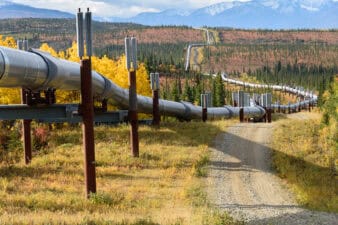At 8.05%, Canadian Oil Sands Ltd. (TSX: COS) currently holds the second-highest yield on TSX. For Canadian Oil Sands investors, this high yield is a key selling point, especially given the fact the company has shown very weak share price growth compared to its peers, and has largely traded flat for the past three years.
Why has it underperformed? Partially because the company has had difficulties hitting production guidance for several years, but also because income investors may be nervous due to the company’s large increase in capital spending on its projects.
The big question now is: With low oil prices, and with increased capital spending, can Canadian Oil Sands maintain its huge yield? Let’s take a look.
There are several risks
Canadian Oil Sands is a pure-play oil sands company that produces 100% high-quality sweet synthetic crude oil through its 36.74% stake in the Syncrude oil sands project. Unlike many of its peers, Canadian Oil Sands is not diversified. It doesn’t produce natural gas, heavy oil, or refined products.
Also, unlike many of its peers, Canadian Oil Sands production is unhedged. The result? Because Canadian Oil Sands produced 100% light sweet synthetic crude and is totally unhedged, investors are fully exposed to the price of oil. Some analysts even say the company is a “pass-through” on the price of oil, or basically a direct play on oil prices.
This is good when WTI prices are high. However, WTI prices trading at three-year lows and projected to remain low — Canadian Oil Sands will experience heavy pressure on its cash flows from operations, more so than its peers.
On top of this, the company has high “operating leverage,” which means it cannot easily scale back production when prices are low. With two major capital projects currently underway and tying up lots of cash flow, and a history of unplanned outages, the dividend faces many risks.
Can the company maintain it?
Currently, the company has a reasonable payout ratio of about 86%. However, when looking at its cash flows, there is more cause for concern. Due to high capital expenditures, as well as shutdowns at two of its cokers in the second quarter, Canadian Oil Sands is no longer producing free cash flow, and is actually negative $303 million in free cash flow for the first time in many years.
How has the company been paying its dividend? Largely by using cash that is left over from when it generated good free cash flow and from a $700 million bond issue the company did back in 2012. Unfortunately, this cash supply is dwindling, with only $82 million remaining as of Q2/2014.
This means the company may have to resort to equity or debt to fund its dividend, if its cash flows do not improve. Fortunately, it has a very strong balance sheet with low levels of debt and a very healthy debt-to-equity ratio, meaning it is in a strong position to withstand low oil prices for a period.
In addition, its two major capital projects are expected to finish up this year and early next year, which should result in a major drop in capital expenditures. In fact, it expects capital expenditures to drop in half by the end of 2015.
This should free up free cash flow once again, which can be used to maintain the dividend. Despite this, if oil prices remain in the $80 dollar range, Canadian Oil Sands estimates its cash flow from operations will also drop to nearly $2 per share, down from their 2014 estimate of almost $3 per share with $95 oil prices.
The takeaway? With the companies reduced capital expenditures, it should be able to still produce free cash flow even with the weakened oil price, but it may need to rely on debt or equity issues should prices stay low for a long period. This is not a low-risk dividend, but it should be sustainable for the near term, especially if oil prices improve.








